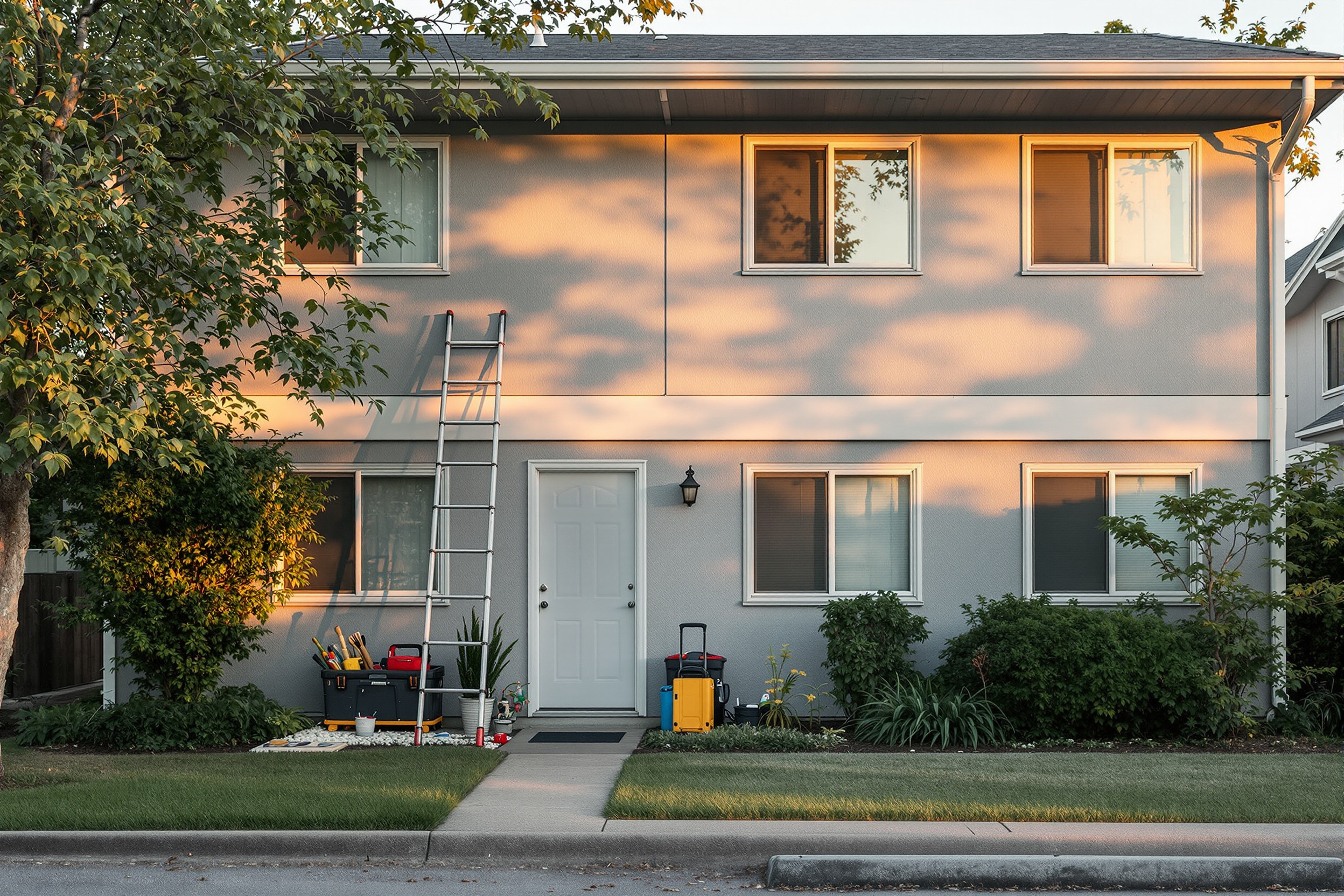It's the day after your tenant has moved out, and you're standing in their now-vacant apartment. You notice scuffed walls, a broken window latch, and a lingering odor you can't quite identify. The clock is ticking since you only have a few days to turn the property around before a new tenant moves in. Where do you even begin?
The longer a turnover takes, the more rental income you forgo. With so many tasks to juggle, it's easy to feel overwhelmed.
With this ultimate apartment turnover checklist, you can turn over your rental unit quickly and confidently. Designed for landlords like you, it covers everything from preparing for the turnover to cleaning tips and strategies that speed up the entire process.
Preparing for an Apartment Turnover
Whether it's your first time or your 50th, having a comprehensive rental property turnover checklist can ensure a smooth transition between tenants. Here's how to get started.
Inspect the Unit
A thorough inspection is crucial to understanding the state of your rental unit before the next tenant moves in. During this inspection, document any damage or necessary repairs using videos and photos, check for wear and tear on appliances, fixtures, and other property items, and look for signs of pest infestations or mold growth.
Inspecting safety features, like smoke detectors and carbon monoxide alarms, is also essential to confirm they function properly. Keep detailed records of your findings, including photographs, to help prioritize repairs and improvements.
Make Repairs
After assessing the unit's condition, it's time to plan for any necessary repairs and improvements. Start by organizing maintenance tasks based on their importance and impact on the rental:
- Determine which tasks you can handle yourself and which require professional services.
- Schedule professional services, such as cleaning, painting, or appliance repair, well in advance to avoid delays in the turnover process.
- Establish a timeline for completing all repairs and improvements so the unit is ready for the next tenant.
Communicate with the Tenants
Provide your outgoing renters with a notice to vacate, move-out instructions, and expectations well in advance, including cleaning requirements and guidelines for disposing of unwanted items. It’s also a good idea to provide the tenants with a move-out inspection checklist. They may point out damaged items or items needing to be replaced from wear and tear for you.
Discuss any potential deductions from the security deposit based on your inspection findings. Schedule a final walk-through with the tenant to address any remaining concerns and confirm the unit's condition.
Finally, collect keys, garage door openers, and any other property items from the tenant.
The Ultimate Apartment Turnover Checklist: Key Items to Include
While our downloadable checklist (available below) provides you with a detailed guide, here's an overview of the essential tasks you’ll need to turn over your rental unit:
- Property inspection and documentation: Conduct a thorough move-out inspection of the unit to assess its current condition. Document any damages or necessary repairs, and take photographs for reference.
- Maintenance and repair tasks: Identify and prioritize maintenance tasks based on their urgency and impact on the unit's safety, functionality, and appearance. Schedule any professional services needed to address these tasks.
- Cleaning and sanitizing the unit: Clean the unit completely before the new tenants move in. Be sure to deep clean carpets, wipe down surfaces, change out air filters on HVAC units (if applicable) and sanitize high-touch areas.
- Updating safety features: Check all safety features, such as smoke detectors, carbon monoxide alarms, and fire extinguishers, to ensure they function properly. Install new batteries or replace them as needed.
- Refreshing paint and cosmetic touches: Refresh the unit's appearance by touching up or repainting walls, trim, and doors. Consider replacing any outdated or damaged hardware, such as door handles and cabinet pulls.
- Replacing or repairing damaged fixtures: Inspect all fixtures, including lighting, plumbing, and appliances, for damage or wear and tear. Repair or update these items as necessary.
- Preparing the unit for new tenants: Once all repairs and maintenance tasks are complete, prepare the unit for new residents by ensuring it's clean, safe, and inviting. Provide a welcome packet with important information about the property and local amenities.
Turnover Cleaning Tips
You have two options for cleaning your rental unit during turnover: professional cleaning services or tackling the job yourself.
While hiring a professional cleaning service can save you time and guarantee a thorough job, going the DIY route can be more cost-effective if you're willing to put in the effort. Whichever option you choose, certain areas require special attention during the cleaning process.
Common areas to focus on include kitchens and bathrooms, which often accumulate the most grime and require deep cleaning. Clean refrigerators, ovens, and other appliances inside and out, scrub tile and grout, and sanitize countertops and sinks. Additionally, clean areas that previous tenants often overlook, such as baseboards, windowsills, and light fixtures.
Minimize the environmental impact of your cleaning efforts, and create a healthier living space for your residents by using green cleaning solutions. These eco-friendly products typically contain fewer harsh chemicals, reduce the risk of irritation for those with allergies or sensitivities, and are better for the environment, making them an excellent choice.
%2520(1).png)
How Long Does Tenant Turnover Take?
The time it takes to complete a tenant turnover can vary significantly depending on several factors. Understanding these factors can help you plan accordingly to save time and money and minimize the potential consequences of a prolonged turnover process.
Some of the primary factors affecting turnover time include:
- Extent of necessary repairs and improvements: The more repairs and improvements your rental unit requires, the longer the turnover takes. Coordinating with multiple contractors and waiting for their availability can cause unavoidable delays, but may be necessary.
- Availability of professional services: The turnaround time for professional cleaning, painting, or repair services can impact the overall turnover duration. Scheduling these services in advance can reduce overall turnover time.
- Tenant move-out and move-in dates: Coordinating move-out and move-in dates with your outgoing and incoming tenants can also affect the turnover timeline. Communicating with renters early on can help ensure a smoother transition.
- Seasonal factors: The time of year plays a role in turnover times, as certain seasons may be busier for rental markets and service providers, making scheduling more difficult.
Failing to turn a rental unit over quickly can have several negative consequences. One significant consequence is the loss of rental income since a prolonged turnover means your rental property remains vacant longer.
Extended vacancy periods can also lead to increased utility expenses, routine maintenance charges, and other costs associated with keeping the property in good condition. A unit not quickly turned over may appear neglected or unappealing to prospective tenants, making it more challenging to find a new tenant that is reliable.
Streamlining the Turnover Process
Efficiency in the turnover process is essential for minimizing vacancy periods and maximizing rental income. Here are some tips to help you streamline the process, even if you're an experienced landlord:
- Implement efficient systems: Establish a clear and organized system for managing tasks during the turnover. Some options include creating checklists, assigning responsibilities, and setting deadlines for each task.
- Leverage technology and tools: Use technology to simplify and expedite various aspects of the turnover process. For example, property management software can help you track maintenance requests, schedule professional services, and keep track of tenant communication.
- Maintain open communication with tenants: Clear and timely communication with outgoing and incoming residents is crucial for a smooth turnover. Provide move-out instructions and expectations to tenants well in advance, and keep new renters informed about the unit's readiness.
- Coordinate service providers: Schedule professional services such as cleaning, painting, and repairs as soon as possible to avoid delays. Confirm dates and times with service providers and follow up to ensure they adhere to the agreed-upon schedule.
- Consider preemptive upgrades: If specific elements of your rental property are nearing the end of their useful life or showing signs of normal wear and tear, consider upgrading or replacing them during the turnover process. You can prevent future maintenance issues and reduce the need for repairs during subsequent turnovers.
- Be proactive with inspections: Regularly perform inspections of your rental property, even when occupied. You can identify and address potential issues early on, reducing the amount of work required during the turnover process.
- Stay informed about local market trends: Keeping an eye on local rental market trends can help you anticipate periods of high demand and adjust your turnover timeline accordingly. This enables you to minimize vacancy periods and attract quality tenants.
Ensuring a Smooth Turnover
With this comprehensive apartment turnover checklist, you can promptly address maintenance issues and implement efficient systems for communication and organization. An organized turnover gives you a seamless transition between tenants and keeps your rental property in tip-top shape.
Remember, a well-maintained property attracts and retains high-quality tenants and contributes to the long-term success of your rental business. Using the knowledge and tools shared in this guide, you're well on your way to mastering this essential aspect of property management.
Ready to take your apartment turnover process to the next level? Download our ultimate apartment turnover checklist for a detailed, easy-to-follow guide that covers all the essential tasks to prepare your rental property for its next occupants.








